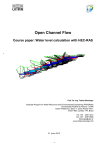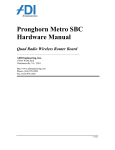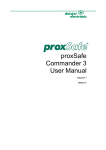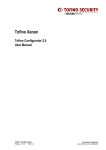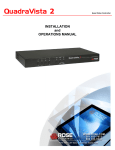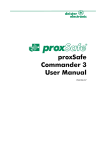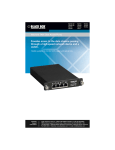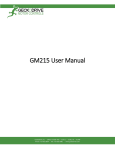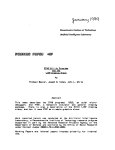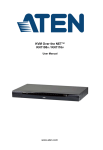Download User`s Manual - Accu-Chek
Transcript
Roche 014103 – Accu-Chek Compact_CAN – Cover Schwarz Cyan Magenta Gelb PMS 249 Prüfmittel-Nr. 30 X ACCU-CHEK Compact BLOOD GLUCOSE MONITOR User’s Manual 0088 Made in Germany for export to: Roche Diagnostics 201 Boul. Armand-Frappier Laval, Québec CANADA, H7V 4A2 Diabetes Care Info-Line: Montreal area: (450) 686-7100 Outside Montreal (toll free): 1-800-363-7949 www.accu-chek.ca Roche Diagnostics GmbH D-68298 Mannheim, Germany www.accu-chek.com 0 3535517001(01) - 02/03 ACCU-CHEK and SOFTCLIX are trademarks of a Member of the Roche Group Integrated test strips ® 014103 AC_Compact_ImP_CAN 12.08.2003 11:23 Uhr Seite u2 CONTENTS CONTENTS 1 Introduction 2 Inserting or replacing batteries 10 3 Inserting or replacing the test strip drum 16 4 Settings 26 4.1 Enabling/disabling the beep tone 4.2 Setting the year 4.3 Changing the date/time format 4.4 Setting the time 4.5 Setting the date 28 30 32 34 36 Performing a blood glucose test 5 6 u2 6 7 Checking, cleaning and storing your monitor 56 7.1 Checking the monitor 7.2 Cleaning the monitor 7.3 Storing the monitor 56 60 65 8 Technical data 66 9 Problem checklist 68 10 Display messages and troubleshooting guide 70 11 Guarantee 90 38 12 Customer support and service 92 5.1 Using the Accu-Chek Softclix lancing device 5.2 Testing blood glucose 5.3 Testing conditions 38 40 48 13 System components 94 14 Alphabetical index 98 Reviewing stored blood glucose results 50 6.1 Highest value, lowest value, average 6.2 Downloading test results to a computer 52 54 1 014103 AC_Compact_ImP_CAN 12.08.2003 1 Display window 2 ON/OFF button 3 MEMO button 4 SET button 5 Optical system 6 Drum compartment release button 7 Drum compartment 8 Test strip drum 9 Test strip 11:23 Uhr Seite 2 11 3 1 4 10 Optical system cover* 10 11 Display cover* 2 5 6 7 8 9 Front edge of strip that draws up the blood * available as replacement part 2 3 2 3 014103 AC_Compact_ImP_CAN 12.08.2003 11:23 Uhr Seite 4 12 Infrared data transmission window 13 Control window (shows the number of strips remaining) 14 Battery compartment 15 Batteries: Type AAA, LR 03, AM 4, Micro 16 Battery compartment cover* 17 Test strip guide 16 13 17 12 14 15 * available as replacement part 4 5 4 5 014103 AC_Compact_ImP_CAN 12.08.2003 11:23 Uhr Seite 6 1 Introduction Accu-Chek Compact is a completely new type of blood glucose monitor for people with diabetes who test their own blood glucose regularly. We have designed it to be as easy and safe to use as possible. You will quickly discover that Accu-Chek Compact is a reliable blood glucose monitor that you can take anywhere. We recommend that you use the Accu-Chek Softclix lancing device to obtain capillary blood samples. Blood collection with an Accu-Chek Softclix lancing device is virtually pain-free. With Accu-Chek Compact you’ve got it all at your fingertips. You can monitor your blood glucose quickly, simply, and with no cumbersome preparations – anywhere, anytime. Operating Accu-Chek Compact is easy: there is just one button to press. You no longer have to handle individual test strips, as they now come conveniently loaded in a drum. Each drum holds 17 strips and two simple steps are all it takes to insert the drum into the monitor. Coding occurs automatically. When you want to take a blood glucose reading, just press the button and a test strip moves from the drum into the correct position. Once you have completed the test, just press the button again and the strip is ejected automatically. Your results are stored in memory and can be transferred to your computer if you wish. 6 7 6 7 014103 AC_Compact_ImP_CAN 12.08.2003 11:23 Uhr Seite 8 1 Introduction This User’s Manual gives you full details of how to operate Accu-Chek Compact. It also tells you how to clean and look after your monitor. At the back of the manual is a list of all possible error messages with recommendations for troubleshooting. Please read carefully all text preceded by the following symbols: Warning! This warns of a situation that may pose a risk to your health (e.g. as a result of you calculating the wrong insulin dose). Important! This symbol highlights important information that will help you get the most out of your monitor. Please take time to read this Manual and the instructions that came with your lancing device and test strip drums. Also, when you have a quiet moment, practise testing. To help you learn, check the instructions and other information in this Manual against the description of the monitor’s parts on pages 2-5. Check that the pack contains all of the items listed. If any are missing, please call our Diabetes Care Info-Line (for details see Chapter 12 “Customer support and service”). Caution! This symbol indicates that your monitor is at risk of being damaged (e.g. through improper cleaning), or that there may be a problem during testing. 8 9 8 9 014103 AC_Compact_ImP_CAN 12.08.2003 11:23 Uhr Seite 10 2 Inserting or replacing batteries If the monitor is on, turn it off. 2 1 Press lightly on the lid of the battery compartment and slide it in the direction of the arrow 1 . Open the battery compartment 2 . Opening the battery compartment 10 10 11 10 11 014103 AC_Compact_ImP_CAN 12.08.2003 11:23 Uhr Seite 12 2 Inserting or replacing batteries Remove any used batteries. Battery types Insert two batteries (type AAA, LR 03, AM 4 or Micro). Make sure that the minus (-) pole of the battery is next to the minus contact in the battery compartment. A new set of batteries provides enough power to carry out a minimum of 500 blood glucose tests. When battery power is low, the battery symbol will appear. You can then perform a minimum of 50 more blood glucose tests. 12 13 12 13 014103 AC_Compact_ImP_CAN 12.08.2003 11:23 Uhr Seite 14 2 Inserting or replacing batteries Replacing batteries Important When you replace the batteries, your stored results are retained in memory. However, you will need to re-enter the date and time. If you fail to do so, any blood glucose test results you obtain from this point forward will be displayed and saved without the date and time. In this case, the test results saved in memory will be numbered consecutively so you can still see the order in which you took the readings. To keep things simple, we recommend you use up any current drum of strips before replacing the batteries. Otherwise, it may take the monitor a long time to advance the first test strip from the next drum, and the “use-by” date warning may also be lost. (see Chapter 3). Please take used batteries to a collection point or to your local dealer. 14 15 14 15 014103 AC_Compact_ImP_CAN 12.08.2003 11:23 Uhr Seite 16 3 Inserting or replacing the test strip drum If the monitor is on, turn it off. Wait for the motor to stop before you open the monitor. Slide the release button on the right side of the monitor in the direction indicated by the arrow. The drum compartment opens. Opening the drum compartment 16 17 16 17 014103 AC_Compact_ImP_CAN 12.08.2003 11:23 Uhr Seite 18 3 Inserting or replacing the test strip drum To exchange the drum, first tip the monitor upright. The old drum drops out. 18 19 18 19 014103 AC_Compact_ImP_CAN 12.08.2003 11:23 Uhr Seite 20 3 Inserting or replacing the test strip drum Insert the new drum. Close the drum compartment. The monitor automatically moves the drum to the correct position and reads the code on the drum. Closing the drum compartment 20 21 20 21 014103 AC_Compact_ImP_CAN 12.08.2003 11:23 Uhr Seite 22 3 Inserting or replacing the test strip drum 13 A dot appears in the small control window 13 on the reverse side of the monitor. This dot indicates that you have inserted a new, full drum containing 17 test strips. When you perform a blood glucose test, the monitor counts the number of test strips that have been used and displays the number of strips remaining. When all the strips have been used, the dot reappears in the control window. “End” flashes in the display, indicating that the drum is empty. 22 23 22 23 014103 AC_Compact_ImP_CAN 12.08.2003 11:23 Uhr Seite 24 3 Inserting or replacing the test strip drum Warning Handle the test strip drums with extreme care! If the aluminium foil (the silver ends) on a new test strip drum has been damaged, do not use it. If you do, your blood glucose test results may be incorrect. Once you remove a drum from its container, you have 90 days to use up all the test strips. The monitor counts the number of days remaining. Do not open the drum compartment until all of the strips have been used. Whenever the drum compartment is opened and closed, or when the batteries are replaced, the monitor thinks a new drum has been inserted, and resets the 90-day countdown. If an open test strip drum is removed from the monitor and reinstalled, the 90-day “use-by” period displayed on the monitor ceases to have any significance. The message “CTRL” flashes in the display indicating that a quality control test should be performed. Perform a quality control test (as described in Chapter 7.1) to ensure that the strips are still usable. The display indicating the 90-day “use-by” period (flashing drum symbol and date) is still invalid, however. If you use expired test strips, you may obtain incorrect blood glucose test results. 24 25 24 25 014103 AC_Compact_ImP_CAN 12.08.2003 11:23 Uhr Seite 26 4 Settings SET menu You may now move to the SET menu to enable or disable the beep tone, to set the year, date and time, and to define the time and date format. Press the SET button to call up the SET menu. The field currently flashing in the menu may now be changed. To quit the SET menu, press the ON/OFF button. 26 27 26 27 014103 AC_Compact_ImP_CAN 12.08.2003 11:23 Uhr Seite 28 4.1 Enabling/disabling the beep tone When the beep tone is enabled, the monitor beeps when it starts to test, as confirmation that the test strip has received a sufficient amount of blood or control solution. It also beeps each time it displays a message. MEMO button 3. Press the MEMO button to disable the beep tone. “OFF” appears in the display. If you press the MEMO button again, “ON” reappears. SET button 1. Check the monitor is off and press the SET button. The monitor turns on without advancing a test strip from the drum. 2. The symbol for the beep tone flashes in the display window, and “ON” appears. ON/OFF button 4. If you wish to set the year, leave the monitor turned on and proceed to step 2 in the next section. If not, press the ON/OFF button to turn the monitor off. The current settings will be saved automatically. 28 29 28 29 014103 AC_Compact_ImP_CAN 12.08.2003 11:23 Uhr Seite 30 4.2 Setting the year SET button 1. Check the monitor is off and press the SET button. The monitor turns on without advancing a test strip from the drum. 2. Press the SET button repeatedly until the current year setting flashes at top right of the display. ON/OFF button 4. If you wish to define the date and time format, leave the monitor turned on and proceed to step 2 in the next section. If not, press the ON/OFF button to turn the monitor off. The current settings will be saved automatically. Important MEMO button 3. Press the MEMO button to adjust the year. The monitor scrolls upwards through the year values. If you hold the MEMO button down, the monitor fast-scrolls forward to 2032 and then begins again at 2000. The year is not displayed during testing or review of blood glucose test results. It is still important, however, as February 29 in a leap year will only be recognised when the year is properly set. The current year setting is also needed to unambiguously identify your blood glucose test results if you transfer them from your monitor’s memory to a computer. 30 31 30 31 014103 AC_Compact_ImP_CAN 12.08.2003 11:23 Uhr Seite 32 4.3 Changing the date/time format MEMO button If you have a new monitor or you have just replaced the batteries, the date will be set to 01.01.2000, and the time to 00:00 hours. The correct date and time are needed to enable you to unambiguously identify your blood glucose test results and to transfer them from your monitor's memory to a computer (see Chapter 6.2). You can choose between the standard 24-hour format (0:00 to 24:00), in which case the date format is DD.MM.YY (day followed by month, followed by year), and the 12-hour format (0 to 12 o’clock with a.m. or p.m.). In the latter case the date format changes to MM.DD.YY, i.e. month, followed by day, followed by year. 3. Press the MEMO button to select 12-hour format. In the display you see “12h” and the 12-hour display is set to a.m. ON/OFF button 4. If you wish to set the date, leave the monitor turned on and proceed to step 2 in the next section. If not, press the ON/OFF button to turn the monitor off. The current settings will be saved automatically. Important SET button 1. Check the monitor is off and press the SET button. The monitor turns on without advancing a test strip from the drum. 2. Press the SET button repeatedly until “24h” is displayed. 24-hour format is selected. 32 32 If you do not set the date and time, these fields will be filled with zeroes during testing. Your blood glucose test results saved in memory will be numbered consecutively. However, only blood glucose results that are saved with the date and time will be included in the statistical display (please see Chapter 6.1). 33 33 014103 AC_Compact_ImP_CAN 12.08.2003 11:23 Uhr Seite 34 4.4 Setting the time MEMO button SET button 1. Check the monitor is off and press the SET button. The monitor turns on without advancing a test strip from the drum. 2. Press the SET button repeatedly until the hour field flashes. 5. Press the MEMO button repeatedly to set the minute. ON/OFF button 6. If you wish to set the date, leave the monitor turned on and proceed to step 2 in the next section. If not, press the ON/OFF button to turn the monitor off. The current settings will be saved automatically. MEMO button 3. Press the MEMO button repeatedly to set the hour. Caution At temperatures below minus 10°C the batteries do not have enough power to keep the internal clock functioning. In this event the clock must be reset. Important SET button 4. Press the SET button again. The minute field flashes. Instead of pressing the MEMO button repeatedly, you can hold it down to scroll forward quickly. 34 35 34 35 014103 AC_Compact_ImP_CAN 12.08.2003 11:23 Uhr Seite 36 4.5 Setting the date SET button 1. Check the monitor is off and press the SET button. The monitor turns on without advancing a test strip from the drum. SET button 4. Press the SET button. The day field flashes. 2. Press the SET button repeatedly until the month field flashes. MEMO button 5. Press the MEMO button repeatedly to select the correct day. MEMO button 3. Press the MEMO button repeatedly to select the correct month. ON/OFF button 36 36 6. Press the ON/OFF button to turn the monitor off. The current settings will be saved automatically. 37 37 014103 AC_Compact_ImP_CAN 12.08.2003 11:23 Uhr Seite 38 5 Performing a blood glucose test 5.1 Using the Accu-Chek Softclix lancing device 1. Pull off the Accu-Chek Softclix cap. Insert a new Accu-Chek Softclix lancet in the lancet holder and push it in until it clicks. Remove the protective cap from the lancet with a twisting motion. To avoid injuries, keep cap and replace on lancet before discarding. Use a new lancet each time you take blood to prevent infection and to ensure virtually painless blood sampling. 2. Press the Accu-Chek Softclix cap on again until it clicks. Be sure to align the notch on the cap with the centre of the semicircular cutout on the ejector. 3. Rotate the Comfort Dial on the Accu-Chek Softclix cap to set the penetration depth. If you are using the Accu-Chek Softclix lancing device for the first time, set the Comfort Dial to 1. For thicker or calloused skin, select a higher setting. 4. Press in the priming button until it clicks. Be careful not to press the release button at the same time. The lancing device is primed when a yellow dot appears in the transparent release button. Do not prime the Accu-Chek Softclix lancing device until you are ready to take blood. 38 38 5. Gently press the Accu-Chek Softclix lancing device against the side of the fingertip or earlobe and press the release button. Take care not to push against the priming button or to impede its free movement. Wait a few seconds to allow a droplet of blood to form or gently squeeze the fingertip to develop a drop of blood. Gently touch the front edge of the test strip against the blood. Test strip If you do not obtain sufficient blood, try the test again with progressively higher settings. After obtaining the blood sample, wipe the puncture site with a dry, clean paper towel. If necessary, gently press the towel onto the site and, if bleeding persists, cover with a bandage. 6. To remove the lancet, remove the Accu-Chek Softclix cap. Place the protective cap back on the lancet and slide the ejector forwards to release the lancet. Dispose of lancet in a safe container (a coffee can with a slot in the cover, for instance). 39 39 014103 AC_Compact_ImP_CAN 12.08.2003 11:23 Uhr Seite 40 5.2 Testing blood glucose Warning Blood glucose results can be displayed in 2 different units (mmol/L or mg/dL). Consequently, we sell two different versions of the same monitor. Check that your monitor displays the unit you are accustomed to. Using the wrong unit can cause you to wrongly interpret the test result. Wash your hands thoroughly with warm water and dry them well. Open the display cover. Press the ON/OFF button. The monitor turns on. “ON” appears in the display window, followed by 888 and the date line. Shortly afterwards a test strip is advanced from the drum. 40 41 40 41 014103 AC_Compact_ImP_CAN 12.08.2003 11:23 Uhr Seite 42 5.2 Testing blood glucose With a lancing device such as Accu-Chek Softclix prick the side of a fingertip. Gently squeeze the fingertip to develop a small drop of blood. Wait until the flashing hand symbol and blood drop symbol appear in the display and the monitor beeps (as long as the beep tone is enabled). Hold the monitor so the test strip is pointing Applying downwards at a slight angle (see illustration). blood Gently touch the front edge of the test strip against the blood. The strip draws up the blood. As soon as the correct amount of blood has been drawn up, the monitor beeps and the test commences automatically. The monitor recognizes if too little blood has been applied and displays an error message. 000 appears in the display at the start of the test. 42 43 42 43 014103 AC_Compact_ImP_CAN 12.08.2003 11:23 Uhr Seite 44 5.2 Testing blood glucose The three 000 in the display gradually disappear. When they have totally disappeared, the test is complete and the test result is displayed. The test strip symbol flashes. Press the ON/OFF button. This saves the test result to memory, releases the strip and turns the monitor off. Hold the monitor upright so the used test strip falls out at the bottom. Used test strip ejected 44 45 44 45 014103 AC_Compact_ImP_CAN 12.08.2003 11:23 Uhr Seite 46 5.2 Testing blood glucose mmol/L short display segment check If your blood glucose test result does not agree with the way you feel, please contact your doctor. If the message HI is displayed, your blood glucose result is above 33.3 mmol/L. If the message LO is displayed, your blood glucose result is below 0.6 mmol/L. The results obtained will not be used in statistical calculations (see Chapter 6.1 “Highest value, lowest value, average”). If a segment is missing from one of the three 888 at power-on (in the display segment test), or if strange characters appear instead of a proper blood glucose result, the display is malfunctioning. Please do not run any more blood tests; contact our Diabetes Care Info-Line (please refer to Chapter 12: “Customer support and service”). Do not reuse a test strip that has been completely ejected from the monitor. Do not allow your Accu-Chek Compact monitor to be used by more than one person. To do so would place all users at risk of infection (see Chapter 7.2 “Cleaning the monitor”). Keep the test strip away from skin unless you are touching it against blood or control solution. Do not bend the test strip, or an error message will be displayed. mmol/L full display segment check Important If you hold down the ON/OFF button for a few seconds when you turn the monitor on, you can perform a full segment check. Do this to verify that all of the display segments are properly displayed. When performing a quality control test, refer to the list of expected values given on the peel-off label attached to the test strip drum container. Keep this label until you have used up all the strips in that drum. Accu-Chek Compact turns off automatically after 5 minutes of non-use. After a blood glucose test result has been displayed, the monitor turns off automatically after 60 seconds. Please dispose of used test strips with your regular household waste. 46 47 46 47 014103 AC_Compact_ImP_CAN 12.08.2003 11:23 Uhr Seite 48 5.3 Testing conditions To obtain reliable blood glucose test results, ensure the following conditions are met: Temperature range The test must be carried out at a temperature between plus 10°C and plus 40°C, because chemical reactions are affected by temperature. If the test is performed at a temperature outside this range, the test result may be incorrect. At ambient temperatures outside this range, the monitor turns off automatically, or error messages or results are displayed together with the thermometer symbol. Do not make treatment decisions based on such results. They are for reference only. Humidity Relative humidity must be below 85 %. A sudden change in temperature can cause moisture to condense on or inside the monitor. If this happens, do not turn the monitor on. Wait until it is thoroughly dry again. Make sure that it returns to room temperature slowly. Electromagnetic fields Very strong electromagnetic fields may affect the monitor’s performance. Such electromagnetic fields can occur in the open near transmitters (radio, television, CB stations and hand-held sets, mobile telephones), and in the household near electrical equipment (microwave ovens, poorly suppressed electrical equipment). If this happens, the error message “Err” is displayed. Move to a different location and repeat the test. Interference from electromagnetic fields 48 49 48 49 014103 AC_Compact_ImP_CAN 12.08.2003 11:23 Uhr Seite 50 6 Reviewing stored blood glucose results Accu-Chek Compact stores up to 100 test results together with date and time. Any important information that was displayed along with the test result is saved as well. For instance, if the thermometer symbol was displayed as a warning during a test because the ambient temperature was too high or too low, this information is stored along with the test result. SET button Press the SET button to move towards the “oldest” result stored. Press the MEMO button to scroll forward to the “newest” result again. You can hold down the buttons to scroll through your results more quickly. MEMO button With the monitor turned off, press the MEMO button. ON/OFF button The monitor turns on without advancing a test strip from the drum. The most recent test result and “MEMO” are displayed. Press the ON/OFF button to turn the monitor off. A test strip is not ejected. 50 51 50 51 014103 AC_Compact_ImP_CAN 12.08.2003 11:23 Uhr Seite 52 6.1 Highest value, lowest value, average Your monitor can display the highest and lowest blood glucose results and the average (or mean) of current test results. Statistics are based on the test results stored for the last 7 days, as long as they were saved with date and time. If more than 100 tests were carried out during this period, statistics will be based on the last 100. MEMO button Press the MEMO button again. The highest measured test result is displayed together with date and time. MEMO button Press the MEMO button to enter the memory mode. The monitor turns on without advancing a test strip from the drum. MEMO button Press the MEMO button again. The lowest measured test result is displayed together with date and time. MEMO button and SET button ON/OFF button Press the SET and MEMO buttons at the same time. The average of your current test results is displayed, identified by an “A”. Press the ON/OFF button to turn the monitor off. A test strip is not ejected. 52 53 52 53 014103 AC_Compact_ImP_CAN 12.08.2003 11:23 Uhr Seite 54 6.2 Downloading test results to a computer Install the software according to the manufacturer’s instructions. Locate the infrared interface on the Accu-Chek Compact 12 . The blood glucose test results stored in your monitor can be downloaded to a computer. This way you can keep a permanent record of long-term trends in your blood glucose values. To transfer stored blood glucose test results to a computer, you need the appropriate hardware and software for infrared data transfer (please call our Diabetes Care Info-Line – see Chapter 12 for details). Infrared adaptor Position the infrared adaptor less than 10 cm away, so the two infrared windows are pointing toward one another. Press the SET button and MEMO button at the same time. The monitor turns on without advancing a test strip from the drum. The monitor automatically downloads all stored blood glucose test results to your computer. Two arrows flash in the display during the download. Once downloading has finished, the monitor turns off automatically. A message is displayed on the computer indicating that the data transfer is complete. The computer turns Accu-Chek Compact off. Important 12 If data transfer did not occur or was incomplete, the monitor turns off automatically after 5 minutes. To make the most of the download feature, you must set the year, date and time in your monitor. 54 55 54 55 014103 AC_Compact_ImP_CAN 12.08.2003 11:23 Uhr Seite 56 7 Checking, cleaning and storing your monitor 7.1 Checking the monitor To ensure reliable results, you must periodically check the performance of your Accu-Chek Compact. Do this by running a quality control check using Accu-Chek Compact Control Solution (not supplied with the monitor). When should I check my Accu-Chek Compact system? When you open a new pack of test strips. After you have replaced the batteries. Running a quality control test Press the ON/OFF button. The monitor turns on and automatically advances a test strip. Press the SET button. “CTRL” appears in the display (simultaneously with the hand symbol) and is automatically stored along with the result, to flag it in memory as a control test result. Quality control checking If your monitor flashes “CTRL”, indicating that a quality control test is required. After you have cleaned your monitor. If your result does not agree with how you feel. 56 57 56 57 014103 AC_Compact_ImP_CAN 12.08.2003 11:23 Uhr Seite 58 7.1 Checking the monitor Wait for the hand symbol and the blood drop to flash in the display before you apply control solution. Take a bottle of control solution and hold the dropper tip downwards until a hanging drop forms at its end. Gently touch the drop of control solution against the front edge of the test strip near the black notch until the monitor beeps and 000 appears in the display. The monitor runs a test, then displays the result and “CTRL”. Refer to the table of expected values on the peel-off label of the test strip drum container. If the result is outside this range, run another quality control check. If the result of the second test is outside the expected range as well, refer to the “Problem Checklist” in Chapter 9. If you are unable to identify or eliminate the source of the problem, contact our Diabetes Care Info-Line. Please see Chapter 12 for details. Important Control readings (identified by “CTRL”) are not used in statistical calculations. 58 59 58 59 014103 AC_Compact_ImP_CAN 12.08.2003 11:23 Uhr Seite 60 7.2 Cleaning the monitor If the outside of your monitor or the display are dirty, wipe them off with a slightly dampened cloth. If blood has entered the test strip guide, or if the message “OFF” is displayed, clean the monitor as follows: Remove the cover from the measurement optics by slightly squeezing it from both sides 1 and lifting it off 2 . Removing the optical system cover 1 2 60 60 1 61 61 014103 AC_Compact_ImP_CAN 12.08.2003 11:23 Uhr Seite 62 7.2 Cleaning the monitor Clean the measurement optics carefully with a slightly dampened cotton swab or a soft, lintfree cloth. Cleaning the optical system Press the cover back on. Caution Please ensure that the optical system cover (see description of the monitor’s parts on pages 2-3) is firmly in place when you want to test. Otherwise it may block the strip from moving into test position or from being ejected. 62 63 62 63 014103 AC_Compact_ImP_CAN 12.08.2003 11:23 Uhr Seite 64 7.2 Cleaning the monitor 7.3 Storing the monitor A potential risk of infection exists. Medical staff and other persons using Accu-Chek Compact to test blood glucose from more than one patient must be aware that any item coming into contact with human blood is a potential source of infection. (Please see “Protection of Laboratory Workers from Infectious Diseases Transmitted by Blood, Body Fluids, and Tissues”; Second Edition, Tentative Guideline, 1991, Document M29-T2, National Committee for Clinical Laboratory Standards). With the batteries removed, the monitor may be Storing the monitor stored at between minus 40°C and plus 70°C. Please refer to the test strip package insert for the temperature at which to keep the test strips. Caution If you use 70 % alcohol or a strongly diluted rinsing solution in the medical environment, wipe these fluids off immediately after application. Do not use cleaning agents that contain acetic acid (vinegar) or scouring agents because they can damage the display and the measurement optics. Do not store the monitor at above plus 50 °C when it contains batteries. At this temperature and above, the batteries could leak and damage the monitor. At temperatures below minus 10°C the batteries do not have enough power to keep the internal clock functioning. Store the monitor in a dry place to keep it in good working condition. 64 65 64 65 014103 AC_Compact_ImP_CAN 12.08.2003 11:23 Uhr Seite 66 8 Technical data Monitor type Accu-Chek Compact Memory capacity Test principle Determination of glucose in fresh capillary blood by reflectance photometry. For use with venous blood, please refer to the package insert for the test strip drums. 100 test results with time and date, average, highest and lowest blood glucose reading Dimensions 103 x 52 x 31 mm Weight Approx. 120 g with batteries and test strip drum Display Liquid Crystal Display (LCD) with symbols Measuring range 0.6–33.3 mmol/L Sample size Approx. 1.5 µL (millionths of a litre) Measuring time Approx. 8 seconds (depending on concentration) Automatic power-off After 60 seconds / 5 minutes depending on testing status System operating conditions Plus 10°C to plus 40°C Power supply 2 batteries (type AAA, LR 03, AM 4 or Micro) Monitor storage conditions Without batteries and test strips: minus 40°C to plus 70°C With batteries and test strips: plus 2°C to plus 30°C With batteries but without test strips: minus 10°C to plus 50°C Battery life at least 500 readings Interface Infrared interface Safety class III LED/IRED Laser Class 1 Humidity Less than 85 % relative humidity 66 67 66 67 014103 AC_Compact_ImP_CAN 12.08.2003 11:23 Uhr Seite 68 9 Problem checklist If your monitor repeatedly displays error messages, if you have reason to doubt the validity of a test result, or if a quality control check returns a result that is outside the expected range (see Chapter 7.1), please check the following points. Did you perform the test as directed (see Chapter 5)? Is the optical system dirty (see Chapter 7.2)? Do the batteries still have enough power? Are they properly inserted (see Chapter 2)? Did you perform the test within the correct temperature range (plus 10°C to plus 40°C)? Have the proper storage conditions for the monitor and test strip drum been observed (see Chapter 7.3 and the package insert that came with the test strip drum)? For quality control checks: Is the control solution beyond its expiry date (see label on bottle)? Or has the control solution been opened for more than 3 months? For quality control checks: Did you use the correct quality control solution (Accu-Chek Compact Control)? If you have checked these points and still receive error messages or doubt the validity of results, please contact your dealer or support/service representative. Please see Chapter 12 for details of customer support and service centres. Are the test strips beyond their expiry date (see peel-off label on test strip drum container)? Has the 3-month “use-by” period for the drum been exceeded (see pack insert)? 68 69 68 69 014103 AC_Compact_ImP_CAN 12.08.2003 11:23 Uhr Seite 70 10 Display messages and troubleshooting guide When symbols and numbers are shown in purple below, it indicates that they flash in the monitor’s display. Display Cause Action Monitor will not turn on. • Batteries are empty. • Ambient temperature is too low. • Display is damaged. • Monitor is defective. • Insert new batteries. • Move somewhere warmer and repeat the test. Battery power is sufficient for a maximum of 50 more tests. Continue testing until all the test strips in the test strip drum have been used. Then insert two new batteries (type AAA) and a new test strip drum. Battery symbol appears and disappears after 3 seconds. Insufficient battery power – no further tests can be performed. Insert two new batteries (type AAA). Clock has stopped. Clock is slow after the monitor is turned on. The monitor was exposed to temperatures below minus 10°C, and the batteries are starting to freeze. Always store the monitor at above minus 10°C. • Contact our Diabetes Care Info-Line (for details see Chapter 12 “Customer support and service”). 70 71 70 71 014103 AC_Compact_ImP_CAN 12.08.2003 11:23 Uhr Seite 72 10 Display messages and troubleshooting guide Display mmol/L Cause Action Temperature was outside the indicated range during testing. The displayed test result may only be used for reference purposes. It is saved along with the thermometer symbol. To perform an accurate test, let the monitor and test strips slowly cool down or warm up, and repeat the test. The optimum measuring temperature is between plus 10°C and plus 40°C. It is too warm or too cold for the test, i.e. warmer than plus 45°C or colder than plus 5°C. No test result is displayed or saved. Let the monitor and test strips slowly cool down or warm up, and repeat the test. The optimum measuring temperature is between plus 10°C and plus 40°C. There was not enough blood on the strip. Repeat the test with a larger drop of blood. The test strip drum in the monitor is empty. Insert a new drum. If the message is still displayed, please contact our Diabetes Care Info-Line (for details see Chapter 12 “Customer support and service”). A dot appears in the control window at the back of the monitor. 72 72 73 73 014103 AC_Compact_ImP_CAN 12.08.2003 11:23 Uhr Seite 74 10 Display messages and troubleshooting guide Display Cause Action The bar code information stored from the test strip drum has been lost. Open the drum compartment and close it again. Caution The display showing the 90-day “use-by” period will be lost (see Chapter 3). or There is no test strip drum in the monitor. Insert a test strip drum. You inserted a test strip drum that has already been used. The monitor cannot determine how long the test strip drum has been outside the monitor, or whether it is still usable. If you are certain that the 3-month “use-by” period has not been exceeded, you may continue to use the drum. Perform a quality control check. The result of the quality control check will be stored in memory along with “CTRL”, and the drum symbol will remain displayed until a new drum is inserted. If you do not perform a quality control check, the flashing drum symbol and the flashing “CTRL” will appear with every new test until a new drum is inserted. Until this point, all test results will be stored along with the flashing drum symbol and “CTRL”. 74 75 74 75 014103 AC_Compact_ImP_CAN 12.08.2003 11:23 Uhr Seite 76 10 Display messages and troubleshooting guide Display Cause Action Drum symbol and “E-2” flash when the first drum from a new pack is inserted. During subsequent tests the drum symbol flashes. The bar code on the drum is damaged. Remove the drum from the monitor and return it to its container. Insert the second drum from the package and use all 17 test strips. When it is time to replace the drum, insert the first drum with the damaged bar code. When the error message is displayed, press the SET button. The monitor uses the code from the previous drum. “CTRL” flashes in the display, requesting you to perform a quality control check. You can use all 17 test strips. The drum symbol continues to flash in the display until a new drum is inserted. Warning All test strip drums in the same package have a bar code unique to that package. Do not try to code the monitor using drums from a different package. Check you are using the correct drums by comparing their lot codes. The lot code is preceded by the symbol LOT . If the message is still displayed, please contact our Diabetes Care Info-Line (for address see Chapter 12 “Customer support and service”). 76 77 76 77 014103 AC_Compact_ImP_CAN 12.08.2003 11:23 Uhr Seite 78 10 Display messages and troubleshooting guide Display Cause Action Drum symbol and “E-2” flash when the second or third drum of a package is inserted. During subsequent tests the drum symbol flashes. The bar code on the drum is damaged. Press the SET button. The monitor uses the bar code from the first drum. The error message disappears. “CTRL” flashes in the display, requesting you to perform a quality control check. You can use all 17 test strips. The drum symbol continues to flash in the display until a new drum is inserted. Warning All test strip drums in the same package have a bar code unique to that package. Do not try to code the monitor using drums from a different package. Check you are using the correct drums by comparing their lot codes. The lot code is preceded by the symbol LOT . If the message is still displayed, please contact our Diabetes Care Info-Line (for details see Chapter 12 “Customer support and service”). 78 79 78 79 014103 AC_Compact_ImP_CAN 12.08.2003 11:23 Uhr Seite 80 10 Display messages and troubleshooting guide Display Cause Action The 3-month “use-by” period has been exceeded. The test strips in the drum are unusable. Insert a new drum. or Warning If you continue to use the drum, carry out a quality control test. The test results obtained under these conditions may only be used for reference purposes. The error message continues to flash in the display until a new drum is inserted. Warning When reviewing results: The test strips used to obtain the stored result were unusable (more than 3 months old). The test results obtained under these conditions may only be used for reference purposes and must not be used for decisions regarding therapy. 80 81 80 81 014103 AC_Compact_ImP_CAN 12.08.2003 11:23 Uhr Seite 82 10 Display messages and troubleshooting guide Display Cause Action • A test error has occurred. • There is electromagnetic interference. • Repeat the test. • Move away from possible sources of interference (see Chapter 5.3 “Testing conditions”). • You forcibly removed the test strip during testing. • You bent the strip while applying blood or during measurement. • The optical system cover may not be closed properly. • Repeat the test with a new strip, this time ejecting it by means of the ON/OFF button. • Repeat the test with a new strip. The test strip is stuck in the guide. Pull the strip out of the monitor. Carefully open the drum compartment and remove the drum without turning it. Reinsert the drum. Close the drum compartment. Keep the “use-by” period in mind when reusing the drum. • Ensure that the optical system cover is firmly in place. 82 83 82 83 014103 AC_Compact_ImP_CAN 12.08.2003 11:23 Uhr Seite 84 10 Display messages and troubleshooting guide Display Cause Action • You touched the test strip against the blood drop too soon. • Turn the monitor off and on again. Repeat the test. Wait until the hand symbol has appeared in the display before touching the test strip against the blood drop. • The optical system is dirty. • The test strips are too old. • The monitor was turned off and on again. The strip is still in the monitor. • You forcibly removed the test strip during testing. • Clean the optical system and repeat the test. • Insert a new test strip drum. • Hold the monitor upright and let the strip drop out, or remove the strip manually, even if it takes a small amount of force. • Repeat the test with a new strip, this time ejecting it by means of the ON/OFF button. The blood glucose result is above the upper limit of 33.3 mmol/L. If this test result agrees with the way you feel, follow your doctor’s advice. If the way you feel does not agree with this test result, please perform a quality control check with Accu-Chek Compact Control and a new test strip. Warning 84 85 84 85 014103 AC_Compact_ImP_CAN 12.08.2003 11:23 Uhr Seite 86 10 Display messages and troubleshooting guide Display Cause The blood glucose result is below the lower limit of 0.6 mmol/L. The download symbols are not displayed, Accu-Chek Compact turns off after 5 minutes and the computer displays a download-related error message. • An error occurred while data was being downloaded. • A bright light source is too close to the infrared adaptor or the monitor. • The monitor and the infrared adaptor are too far away from one another or not correctly aligned. • A computer software error occurred. Action Warning If this test result agrees with the way you feel, follow your doctor’s advice. If the way you feel does not agree with this test result, please perform a quality control check with Accu-Chek Compact Control and a new test strip. • Download the data again. • Increase the distance from the light source. • Decrease the distance between the two units to less than 10 cm. Make sure the two IR windows are pointing toward one another. • Read the Manual for the download software. 86 87 86 87 014103 AC_Compact_ImP_CAN 12.08.2003 11:23 Uhr Seite 88 10 Display messages and troubleshooting guide Display Cause Action • Electrostatic discharge • Switch the monitor off and then on again. • Monitor is defective. • Please contact our Diabetes Care Info-Line (for details see Chapter 12 “Customer support and service”). Important Please note: Several messages may be displayed simultaneously. A combination such as a thermometer, drum symbol, blood glucose result, date and “CTRL” flashing means that - the temperature during measurement was outside the indicated range and the 90-day countdown period for the drum has ended. 88 89 88 89 014103 AC_Compact_ImP_CAN 12.08.2003 11:23 Uhr Seite 90 11 Guarantee Guarantee: The statutory guarantee provisions governing the sale of consumer goods in the country of purchase shall prevail. On packaging, on the type plate and in the User’s Manual you may encounter the following symbols, shown here with their meaning: For in vitro diagnostic use. Do not ingest! IVD 0088 REF This product fulfils the requirements of Directive 98/79/EC on in vitro diagnostic medical devices. Catalogue number Please consult instructions for use Caution (refer to accompanying documents). Please refer to safety-related notes in the manual accompanying this instrument. Manufactured by Last updated: February 2003 90 91 90 91 014103 AC_Compact_ImP_CAN 12.08.2003 11:23 Uhr Seite 92 12 Customer support and service If you have questions or concerns, call the Diabetes Care Info-Line: Montreal area: (450) 686-7100 Outside Montreal (toll free): 1 800-363-7949 Made in Germany for export to: Roche Diagnostics 201 Boul. Armand-Frappier Laval, Québec CANADA, H7V 4A2 www.accu-chek.ca 92 93 92 93 014103 AC_Compact_ImP_CAN 12.08.2003 11:24 Uhr Seite 94 13 System components 1 Accu-Chek Compact 2 Holster for Accu-Chek Compact 3 Accu-Chek Softclix 1 2 3 94 95 94 95 014103 AC_Compact_ImP_CAN 12.08.2003 11:24 Uhr Seite 96 13 System components 4 Drum with 17 test strips. Each drum comes individually packaged in its own container. 5 Accu-Chek Compact Control for checking the performance of your system* 7 6 200 sterile lancets* 6 7 Carry-case 5 4 * available separately 96 97 96 97 014103 AC_Compact_ImP_CAN 12.08.2003 11:24 Uhr Seite 98 14 Alphabetical index E Electromagnetic fields Expiry date, test strips G Guarantee Page B Bar code Batteries, inserting or replacing Battery types Beep tone, enabling/disabling Blood, dosing the strip Blood, too little applied C Checking the monitor Cleaning, monitor Coding, test strip drum Computer, downloading results to a Control features, description Control solution Control window, test strip drum Customer support D Date, setting the date Display messages Drum compartment 74ff. 10ff. 13 28ff. 43 43 56 60ff. 6 54 2 56ff., 69 4, 23 92 32ff. 70ff. 2, 17, 21, 83 H Humidity I Infrared adaptor Introduction 49 24ff. 90 49, 66 32, 55, 86, 87 6 L Lancing device Lot code 7, 38-39, 43 77-79 M MEMO button Monitor, checking monitor performance Monitor, checking the monitor Monitor, cleaning the monitor Monitor, description of Monitor, storing the monitor 2, 29ff., 50ff. 57 56ff. 60ff. 2 64ff. O ON/OFF button 2, 27ff., 41, 45, 51, 53, 57, 83ff. Optical system 2 Optical system, cleaning the optical system 63 Optical system, opening the optical system 61 98 99 98 99 014103 AC_Compact_ImP_CAN 12.08.2003 11:24 Uhr Seite 100 14 Alphabetical index P Performance, checking monitor Problem checklist Q Quality control test Storage temperature, monitor Symbols explained System components 56-59 68-69 25, 47, 57, 71, 79 R Results 14, 24, 31f., 41, 46ff., 50ff. Results, downloading to a computer 54ff. Results, reviewing stored 50ff. Results, reviewing stored results 50ff. Results, transferring stored results 55 S Service Service, customer support and SET button SET menu Setting the time Settings - Date - Enabling/disabling the beep tone - Time - Year 92 92 2 27ff. 34 26ff. 36ff. 28ff. 34ff. 30ff. 65 8, 91 94ff. T Technical data Temperature range Test strip drum, inserting or replacing Test strip ejection Testing blood glucose Testing conditions Troubleshooting guide 66ff. 48, 70, 72-73 16ff. 45 40ff. 48ff. 70ff. U Units (mg/dL and mmol/L) Use-by date, test strip drum 41 15, 25, 75, 80 V Values, highest, lowest, average 52 W Warnings 8ff. Y Year, setting the year 30ff. 100 101 100 101




















































